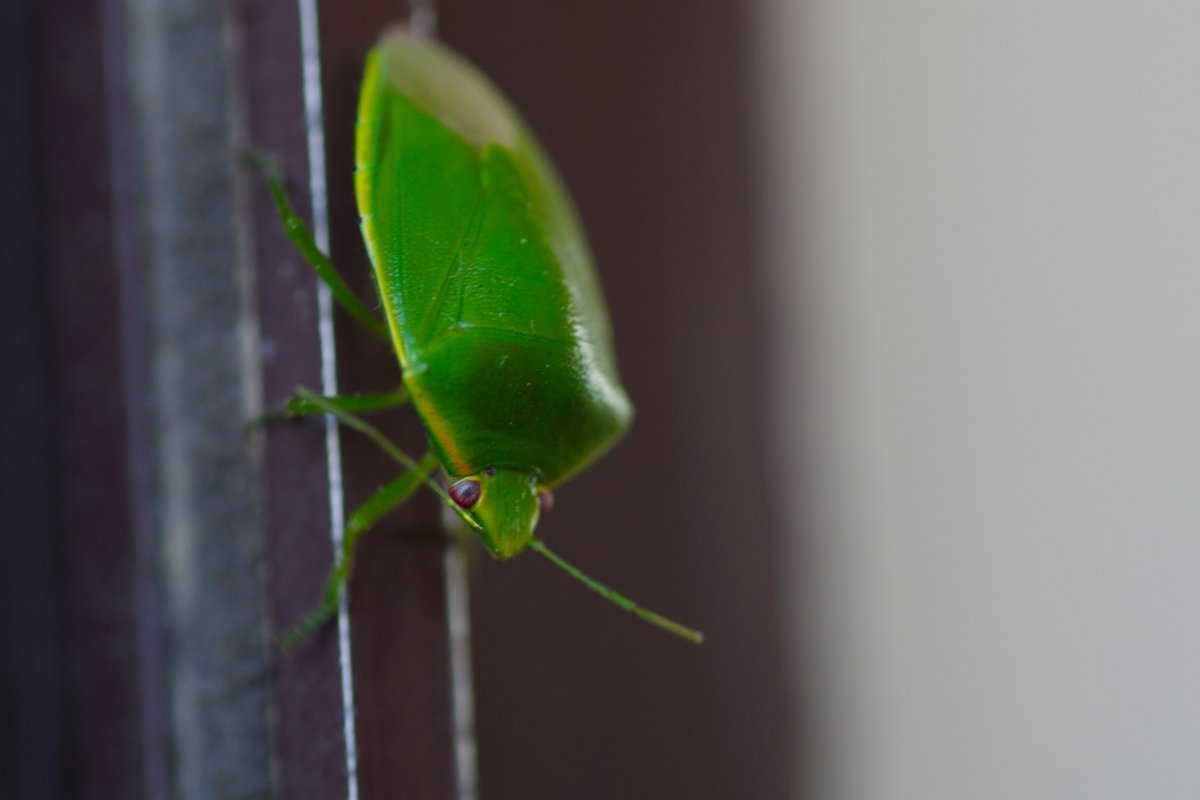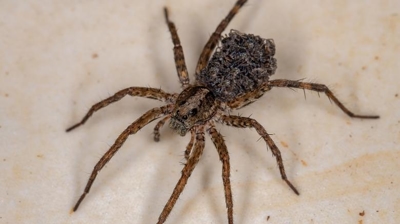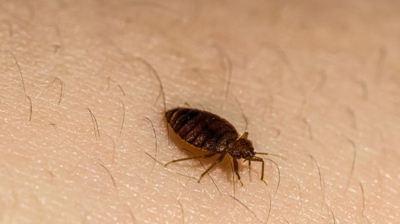
Green Stink Bug Control Services

Green Stink Bugs
Green stink bugs can be considered harmful primarily because they are agricultural pests that feed on a wide variety of crops. They use their piercing-sucking mouthparts to extract juices from fruits, vegetables, and other plants, which can cause significant damage to the produce. This feeding can lead to discoloration, deformities, and a reduction in quality, making the crops less marketable. Additionally, their feeding can introduce disease-causing pathogens into plants, further affecting crop health. In large numbers, green stink bugs can cause substantial economic losses for farmers and gardeners. Their presence can also be a nuisance indoors when they seek shelter during cooler months, releasing a foul odor when disturbed or crushed.
Green Stink Bug Removal
Green stink bugs are more than a simple nuisance—these stink bugs are significant agricultural and structural pests with a combination of traits that make them unusually problematic. These bugs feed by piercing plant tissues and extracting sap, which weakens crops, transmits plant pathogens, and causes direct damage such as “cat-facing” on fruits, shriveled pods on legumes, and seed loss in grains. Their broad diet allows them to attack vegetables, fruit trees, ornamentals, and field crops, making infestations economically costly and difficult to predict. They also reproduce quickly in warm seasons, allowing populations to surge and spread across large areas. Indoors, while they don’t damage structures, their defensive odor is potent and persistent, and large numbers can gather on or inside buildings as they seek overwintering sites. Eliminating them helps protect crop yields, preserve garden health, prevent contamination of stored or harvested produce, and reduce the risk of sizable overwintering invasions that create long-lasting odors and discomfort for homeowners.
Learn more: How To Get Rid Of Green Stink Bugs
Green Stink Bug Control
Hiring professional pest control for green stink bugs (Chinavia hilaris and related species) is strongly recommended for several important reasons. While homeowners can attempt DIY methods, professional intervention is often more effective, safer, and long-lasting. Here’s a detailed breakdown:
- Effective Identification and Targeting: Not all stink bugs behave the same. Our professionals can identify green stink bugs versus brown marmorated or other similar species, which ensures the correct treatment.
- Life cycle knowledge: Green stink bugs have multiple life stages (eggs, nymphs, adults) that require different approaches. Our professionals know when and where interventions will be most effective.
- Comprehensive Treatment Methods: We have access to pesticides and formulations not available to the general public, which are more effective and targeted. Our professionals often use a combination of monitoring, exclusion, and treatment rather than just spraying, which reduces the likelihood of recurrence. We can also seal entry points and treat potential harboring areas to keep stink bugs from returning.
- Safety and Compliance: Some insecticides effective against stink bugs can be toxic if improperly applied. Our professionals are trained to use insecticides safely for humans, pets, and plants. We also know how to minimize environmental impact while controlling infestations.
- Time and Labor Efficiency: DIY approaches often require repeated effort (vacuuming, manual removal, multiple sprays). Our professionals can treat the problem thoroughly and quickly, saving you time and stress.
- Damage Prevention: Green stink bugs feed on fruits, vegetables, and ornamental plants, causing pitting, deformities, and reduced yields. While less of a direct structural threat than termites, green stink bugs can invade homes in large numbers during cooler months, causing odor and staining.
- Long-Term Results: We provide ongoing protective service visits to minimize green stink bug populations, which helps prevent future infestations. Our professionals can also advise on landscaping, storage, or structural changes that minimize stink bug attraction, leading to sustainable control.
While DIY methods might handle a small number of green stink bugs, our professional pest control ensures correct identification, safe and effective treatment, and long-term prevention—saving you time, money, and frustration.
Green Stink Bug Exterminators
Hiring our local exterminators for green stink bug control offers several advantages that national chains typically can’t match. Our local professionals understand the regional biology of green stink bugs—when they emerge, which plants they target most heavily in your area, and how weather patterns influence their movement. That localized knowledge allows us to time treatments precisely and choose the most effective methods for your specific climate and vegetation, rather than relying on generic national protocols.
Our local technicians also give more responsive service. Green stink bugs can multiply quickly during warm periods, and delays can allow a minor issue to become a full-scale invasion. Our team provides faster callbacks, flexible scheduling, and the ability to adjust treatment plans immediately if conditions change. Our inspections are also more thorough, because our team depends on our reputation and word-of-mouth rather than national advertising.
Another important difference is customization. National companies often use standardized chemical routines that aren’t optimized for pests like stink bugs, which require targeted perimeter treatments, exclusion work, and habitat modification rather than broad-spectrum spraying. Our local exterminators tailor an integrated approach—closing entry points, treating high-pressure exterior zones, managing nearby vegetation, and recommending property-specific prevention steps—reducing the chance of re-infestation.
Our locally operated team provides clearer accountability. You know who’s treating your property, and that we’re invested in your long-term satisfaction because your community is our community. That personal investment leads to better follow-through, thorough assessments, and more reliable results when dealing with difficult seasonal pests like green stink bugs.
What Do Green Stink Bugs Look Like?
Green stink bugs, scientifically known as Nezara viridula, are distinctive in their appearance. Here is what green stink bugs look like:
- Size and Shape: Green stink bugs are typically about 12-15 mm (0.5-0.6 inches) in length. They have a flattened, shield-shaped body with a slightly elongated, oval outline. Their body shape is often likened to that of a medieval knight's shield.
- Color: As the name suggests, green stink bugs are primarily green in color. However, the specific shade of green can vary among individuals, ranging from a bright, vibrant green to a more muted or yellowish-green. This green coloration helps them camouflage among leaves and vegetation.
- Markings: They may have varying patterns or markings on their bodies, but a common feature is a triangular scutellum, which is a distinctively shaped shield-like structure on their backs, covering the wings. This scutellum is usually bordered by alternating light and dark bands or stripes. The outer edges of their wings may also have subtle patterns.
- Antennae: Green stink bugs have long, slender antennae that extend from their heads. These antennae are segmented and are often visible when looking closely at the insect.
- Legs: Their legs are relatively long and slender, which aids in their mobility. They have three pairs of legs, like most insects.
- Wings: Green stink bugs have well-developed wings, which are folded flat over their bodies when at rest. These wings are used for flying, although they are not strong fliers and typically fly short distances.
- Mouthparts: They possess piercing-sucking mouthparts that they use to puncture plant tissues and feed on the sap or juices of plants. These mouthparts are typically not easily visible without close examination.
- Odor Gland: Another distinctive feature is their odor gland, which is located on their abdomen. When threatened or handled, they can emit a foul-smelling odor as a defense mechanism.
Green stink bugs are medium-sized insects with a shield-shaped body that is primarily green in color, often with distinct markings. They have long antennae, three pairs of legs, wings for flying, and a recognizable triangular scutellum on their backs. Their green coloration and shield-like shape make them stand out, especially when they are seen on plants and vegetation.
Where Are Green Stink Bugs Found?
Green stink bugs (Nezara viridula) can be found in various locations, as they are adaptable insects that are associated with plants. Their distribution can span both agricultural and natural environments. Here are some places where you might encounter green stink bugs:
- Agricultural Fields: Green stink bugs are often found in agricultural settings. They can infest a variety of crops, including soybeans, cotton, corn, and various fruits and vegetables. Farmers and agricultural workers commonly encounter them in fields where these crops are grown.
- Gardens: Home gardeners may also encounter green stink bugs in their gardens, especially if they grow vegetables, fruits, or ornamental plants. Stink bugs can be particularly bothersome in gardens as they feed on plant sap and fruits, causing damage to the crops.
- Orchards: Orchards that grow fruits like apples, peaches, and pears are susceptible to green stink bug infestations. The bugs can damage the fruits by piercing the skin and feeding on the juice.
- Natural Habitats: Green stink bugs are not restricted to cultivated areas. They can also be found in natural habitats, such as woodlands, grasslands, and meadows. Here, they may feed on wild plants and shrubs.
- Weedy Areas: Stink bugs are known to inhabit weedy areas, especially if these areas have suitable host plants for feeding and reproduction. Weeds can provide an ideal habitat for them.
- Residential Areas: In urban and suburban environments, green stink bugs may occasionally find their way into residential neighborhoods. They can be seen on shrubs, trees, and garden plants.
- Overwintering Sites: In colder regions, green stink bugs seek shelter during the winter. They may congregate in large numbers in protected locations such as buildings, sheds, or other structures to overwinter. This is when people often notice them inside their homes.
- Transported Goods: In some cases, green stink bugs can be inadvertently transported from one location to another in shipments of agricultural products or other goods. They may then establish themselves in new areas.
Green stink bugs are plant-feeding insects, and their presence is primarily linked to the availability of host plants. Their habitat can vary depending on the life stage and the time of year. While they may not be harmful to humans, they can be considered agricultural pests due to the damage they cause to crops. Effective pest management practices are often employed in agricultural settings to control their populations.
What Do Green Stink Bugs Eat?
Green stink bugs (Nezara viridula) are herbivorous insects that primarily feed on plant material. They use their piercing-sucking mouthparts to puncture plant tissues and extract the sap or juices, which can lead to damage to crops and plants. Here is an overview of what green stink bugs eat:
- Fruits: Green stink bugs are known to feed on a wide range of fruits. This can include fruits like apples, peaches, pears, and citrus fruits. They puncture the skin of the fruit and extract the juice, which can result in cosmetic damage and reduced fruit quality.
- Vegetables: These insects can be particularly problematic for vegetable crops. Green stink bugs may feed on vegetables such as tomatoes, peppers, beans, and okra. They can cause damage to the plants by extracting sap from leaves and stems.
- Crops: In agriculture, green stink bugs can be a significant pest for crops like soybeans, cotton, corn, and various grains. Their feeding can reduce crop yields and negatively impact the quality of agricultural products.
- Legumes: Stink bugs are known to infest leguminous crops, such as lentils and peas, where they feed on plant tissues and can cause damage to the crop.
- Ornamental Plants: Green stink bugs may also feed on ornamental plants in gardens and landscapes. They can puncture leaves and stems, which can result in cosmetic damage to ornamental shrubs and flowers.
- Weeds: Stink bugs can also be found on weedy plants and may feed on a variety of weed species.
Green stink bugs are highly polyphagous, meaning they can feed on a wide range of plant species. Their feeding can result in the deformation of plant tissues, reduced plant vigor, and a decrease in crop yields. Effective pest management strategies are often employed in agriculture to control their populations and minimize the damage they can cause to crops.
Green Stink Bug Life Cycle
The life cycle of green stink bugs (Nezara viridula) consists of several stages, including egg, nymph, and adult. These insects undergo incomplete metamorphosis, meaning that their immature stages, known as nymphs, resemble the adults but are smaller and go through a series of molts before reaching maturity. Here is an overview of the life cycle of green stink bugs:
- Egg Stage: Female green stink bugs lay clusters of small, barrel-shaped eggs on the underside of leaves or on plant stems. The eggs are typically light green to yellowish in color and are often laid in a hexagonal pattern. The number of eggs in a cluster can vary, but it can range from a few dozen to over a hundred, depending on environmental conditions and the female's reproductive capacity.
- Nymph Stage: After an incubation period of about 4-10 days, the eggs hatch, giving rise to nymphs. Nymphs resemble small, wingless versions of the adult stink bugs but are often more brightly colored. Nymphs go through several molts (usually five) as they grow and develop. During each molt, they shed their exoskeleton to accommodate their increasing size. The color of nymphs can vary but may include shades of green or yellow, often with distinctive markings and red or orange coloration on the abdomen and antennae. Nymphs actively feed on plant sap and undergo gradual metamorphosis until they reach maturity.
- Adult Stage: Once nymphs have gone through their final molt, they reach adulthood. Adult green stink bugs are typically about 12-15 mm (0.5-0.6 inches) in length. Adult green stink bugs have fully developed wings, enabling them to fly. They are sexually mature and capable of reproducing. The distinctive green coloration with a triangular scutellum, as well as their shield-shaped bodies, is most prominent in adults.
- Reproduction: During the warm months of the year, adult green stink bugs mate, and females lay eggs to begin the next generation. The life cycle may have multiple generations in a single growing season, especially in regions with favorable climatic conditions.
- Overwintering: In colder regions, adult green stink bugs seek overwintering sites in the fall. They may congregate in protected locations, such as buildings, sheds, or other structures, to survive the winter. They become dormant during the winter months and resume activity in the spring, potentially emerging as a nuisance in homes or other structures.
The life cycle of green stink bugs can vary depending on environmental factors, such as temperature and the availability of host plants. They are considered pests in agriculture due to their feeding habits, which can damage crops. Integrated pest management practices are often employed to manage and control their populations in agricultural settings.

Hear From Our Happy Customers
-
"Great Communication"
Tech was on time, communication was great, and he accommodated my needs.
- Alonzo W. -
"Professional & Considerate"
I’m pleased with Miche services. Jarvis came today. Professional and considerate. Thank you!
- Judy B. -
"Very Knowledgeable"
The tech that arrived was courteous, professional, and very knowledgeable. He was Great.
- Uerial I. -
"Fantastic & Patient"
Jarvis was fantastic and patient. He answered my questions with an in-depth explanation and addressed all of my areas of concern. Would love for him to be my assigned tech going forward. Well done!
- Yonnette M. -
"Exceeds Expectations"
I can’t say enough positive things about this company... The tech that came out, Jarvis went above and beyond my expectations. Thank you guys, I will continue using your services.
- Jake M. -
"Wonderful Service"
Wonderful service. Jarvis is great. Took care of everything I needed. Thank you!
- Henry P.



